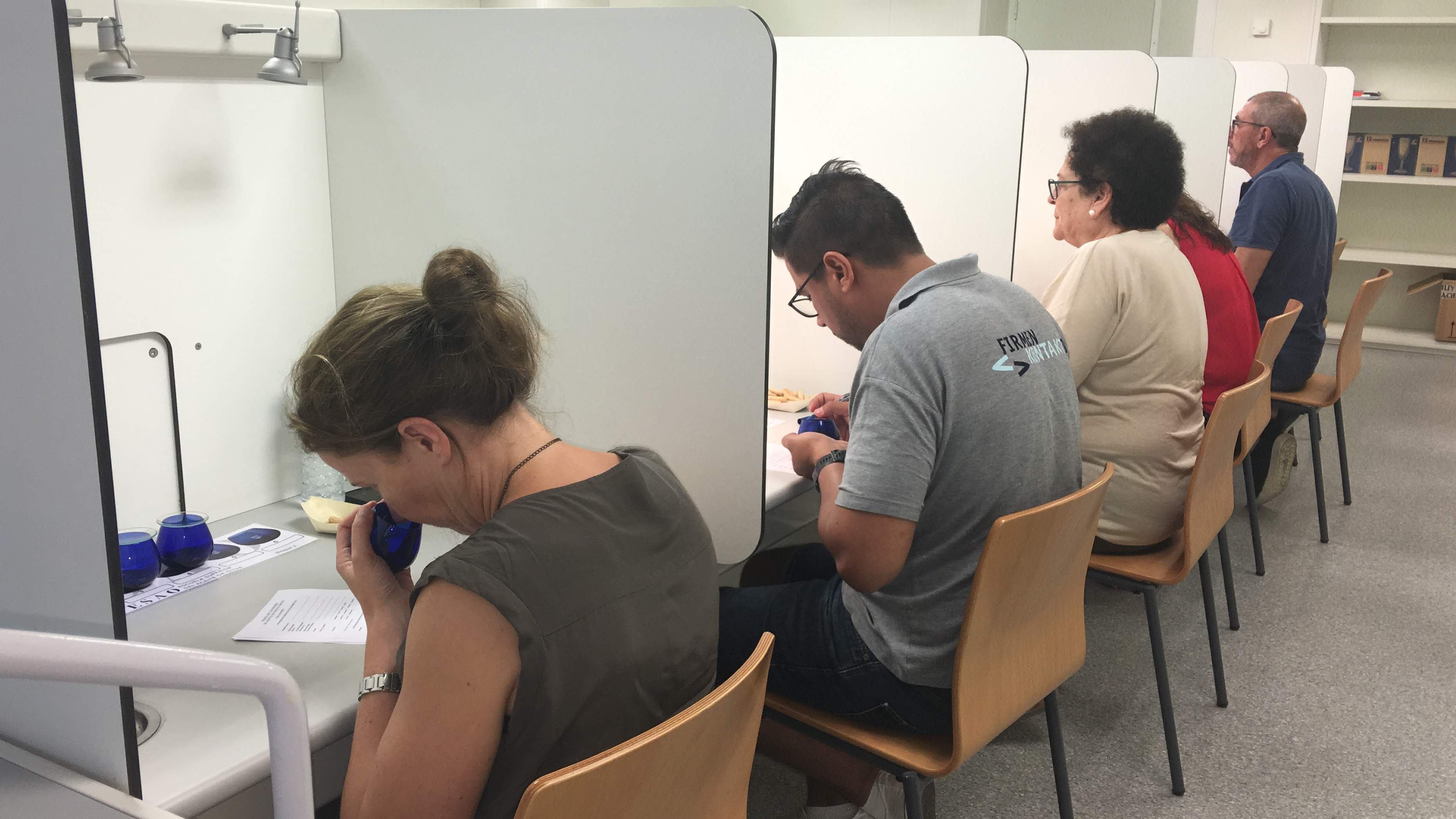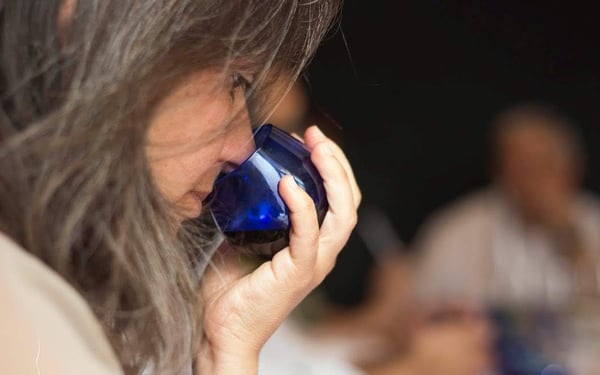Listen to this article
Extra Virgin Olive Oil (EVOO) is the highest quality olive oil there is . It is one of the healthiest fats and besides the health benefits its consumption provides, it is a joy to savour and to use in cooking.
The hundreds of olive tree varieties allow for an infinite number of olive oils. However, obtaining a quality oil depends on how is olive oil made: the variety, time and mode of harvesting and processing. In order to guarantee purity, quality and authenticity extra virgin olive oil has to be analyzed and classified with a double procedure: the physical test and the sensorial analysis. Both methods and parameters are guided by the International Olive Council (IOC) norms.
While the physical test is held in a laboratory and looks for the chemical composition of the oil the sensorial analysis is held by a qualified Olive Oil tasting panel made of olive oil sommeliers.
"an Olive Oil Sommelier is someone highly trained in Olive Oil tasting"
The person highly trained and knowledgeable in olive oil and olive oil tasting is called a Sommelier. Sommelier is a french word that refers to someone who is a trained wine professional, normally working in fine restaurants, who specializes in all aspects of wine service as well as wine and food pairing. In this case, an Olive Oil Sommelier is someone highly trained in Olive oil tasting.
An olive oil taster or olive oil sommelier is trained in the EVOO sensorial analysis, looking at the organoleptic properties of the olive oil using the human senses, mainly olfactory and taste.
Olive Oil Sensorial Analysis
For virgin olive oil, sensorial analysis refers to the evaluation of the smell, taste, and on the mouth sensations.
There have been attempts to develop other methods of sensorial analysis, but to date none of them have proven successful. “Electronic noses” have been around for years but we have seen that they have not been able to describe the sensorial profile of olive oil.
Even though the degree of uncertainty of human sensory analysis may be greater than that of technological systems, as of today it is the only authorized means for classifying virgin olive oils and can only be done by officially certified tasting panels.

Students tasting during the Professional Sommelier Course at ESAO.
To date, the different compounds in a given food are generally so numerous, and their interactions so complex and as yet not totally understood, that quality control must be complemented by sensorial analysis.
The complexity and rich nuances present in the aroma, color and taste of virgin olive oil are an inherent part of its composition, along with the way it is obtained. This is what makes it different from all other vegetable oils.
Virgin olive oil can be consumed straight from the fruit, like any other fruit juice, and this is what gives it its remarkable nutritional and organoleptic characteristics.
Flavor
When we talk about the sensorial analysis in virgin olive oil, we need to look at flavor. We take flavor to mean everything we perceive from an olfactory, taste, tactile, and kinesthetic stimulus that allows us to identify a given food item according to a hierarchy of pleasant or unpleasant. Hence, the flavor characteristics of virgin olive oil is determined by both volatile and nonvolatile compounds.
With virgin olive oil, the human organs we use in sensory analysis are the nose and the mouth, to evaluate the aroma and the taste sensations.
Taste sensations
We are dealing with the mouth cavity. The tongue and the surface of the mouth cavity are where the main perception occurs. But the palate and the sides of the throat and back of the throat also sense flavors.
There are 4 basic flavors normally recognized in our culture: Sweet, acidic/sour, salty, and bitter.
.jpg?width=282&name=pasted%20image%200_800x864%20(1).jpg)
A sweet flavor is found at the tip of the tongue and it is not necessary to introduce a liquid inside the mouth to detect it. All you need is to wet the tip of your tongue on the surface of the oil. A sweet flavor is perceived at its maximum intensity in the first second, and then gradually diminishes until completely disappears after about 10 seconds.
An acidic/sour flavor is perceived along the sides of the tongue and towards the back, and salty flavor is located along the sides but not on the center surface.
Bitterness is sensed at the back of the tongue, it is slow to start but grows and stays longer.
Pungency is not really a flavor stimulus; it is a kinesthetic, or tactile, sensation. It is perceived all over the mouth, but is most notable in the throat.
To be able to do a proper tasting of the four basic flavors, the item being tasted should be in contact with the entire mouth surface, i.e., from the tip of the tongue to the back of the palate.
In our olive oil tasting we use mainly, as is indicated on the official IOC tasting sheet, bitter and pungency.
Since bitter and pungency are considered positive attributes of virgin olive oil, what we consider most is flavor and the kinesthetic sensations, respectively.
Phenol compounds in virgin olive oil are what stimulate taste buds that the perception of bitterness, and the tips of the trigeminal nerves used in the perception of pungency, astringency, and metal attributes in oils. The compounds most closely related to the bitter and pungent sensations so characteristic of virgin olive oil are the phenol compounds. The phenolic profile of an oil influences its oxidative stability given that phenols are anti-oxidants.
There are now many studies relating the anti-oxidant property of these compounds with healthy benefits. The anti-oxidant action is associated with its protective role regarding oxidative-related aging.
The Olfactory sense
The aroma of virgin olive oil is perceived as a result of the interaction between numerous volatile compounds and their corresponding olfactory receptors. In general aroma will be the dominant perception of any food.
The olfactory sense begins functioning when it is stimulated by molecules in the air that we breath in, or by volatile substances in food that are transported to the nose or mouth.
The olfactory sense begins in the nose and includes other parts of the head and brain such as the nasal passages, olfactory neuron receptors, the olfactory bulb, and the brain, which is where we process and identify an aroma.
For a substance in a solution to be aromatically perceived, it must be very light in weight and it must be volatile, which makes it so important for aromatic intensity.
On the other hand, the main compounds in a virgin olive oil, are the triacylglycerols. But since they are heavier, we cannot smell them. We perceive hundreds of thousands of different stimuli, but we cannot list them all because we lack the terms in our languages to make this possible.

Olive Oil Sommelier during olfactory test. Photo by ESAO
The aroma of virgin olive oil is the result of a complex mixture of volatile compounds that includes mostly aldehydes, alcohol, ketones, hydrocarbons, furans, esters. The two first ones are qualitatively and quantitatively the most significant of the volatile compounds in virgin olive oil. These compounds are what give virgin olive oil its characteristically green aroma.
The profile of volatile compounds of an oil will differ according to the quality of the oil; the lower the quality of the oil, the more complicated this profile will be.
That is to say that the volatile compounds in a recently milled, high quality olive oil will have a simpler profile than a low quality oil which will present a greater number of volatile compounds that are responsible for unpleasant aromas which come from diverse enzymatic and chemical routes.
The quality of the oil, the variety, and how mature the olives were, will significantly influence the volatile fraction of a virgin olive oil. In sensorial analysis, we have two fundamental elements: the taster and the oil sample.
"The key to be an excellent olive oil sommelier is education, training and passion"
There are factors that can help or hinder the sensorial accuracy produced from these two elements. And protocol and tasting techniques to be observed and developed over the time. The key to be an excellent olive oil sommelier is education, training and passion. We encourage you to deep dive in the wonderful and vast olive oil world.
.png)



